Eradication of Poverty in Australia: Economic Growth and Inequality
VerifiedAdded on 2021/06/17
|11
|2781
|464
Report
AI Summary
This report, focusing on the eradication of poverty in Australia, provides a comprehensive analysis of the issue, its causes, and potential solutions. It begins by highlighting the global context of poverty and its persistence despite international efforts. The report then delves into the specific challenges faced by Australia, including housing stress, food insecurity, and the vulnerability of women and other groups. A literature review explores the relationship between poverty, economic growth, and income inequality, drawing on existing research and theories. The study employs a conceptual framework to understand these relationships and utilizes a mixed-methods approach, including systematic review and qualitative synthesis, to analyze data. The report presents research questions, aims, and ethical considerations, as well as a detailed methodology. The findings emphasize the need for government policies to improve income distribution, promote education, and address inequality. The report concludes with recommendations for further research and policy interventions, emphasizing the importance of economic stability, resource allocation, and foreign aid to improve the living standards of the poor. The report aims to contribute to the understanding of poverty and its eradication in the Australian context, offering insights for policymakers and the public.
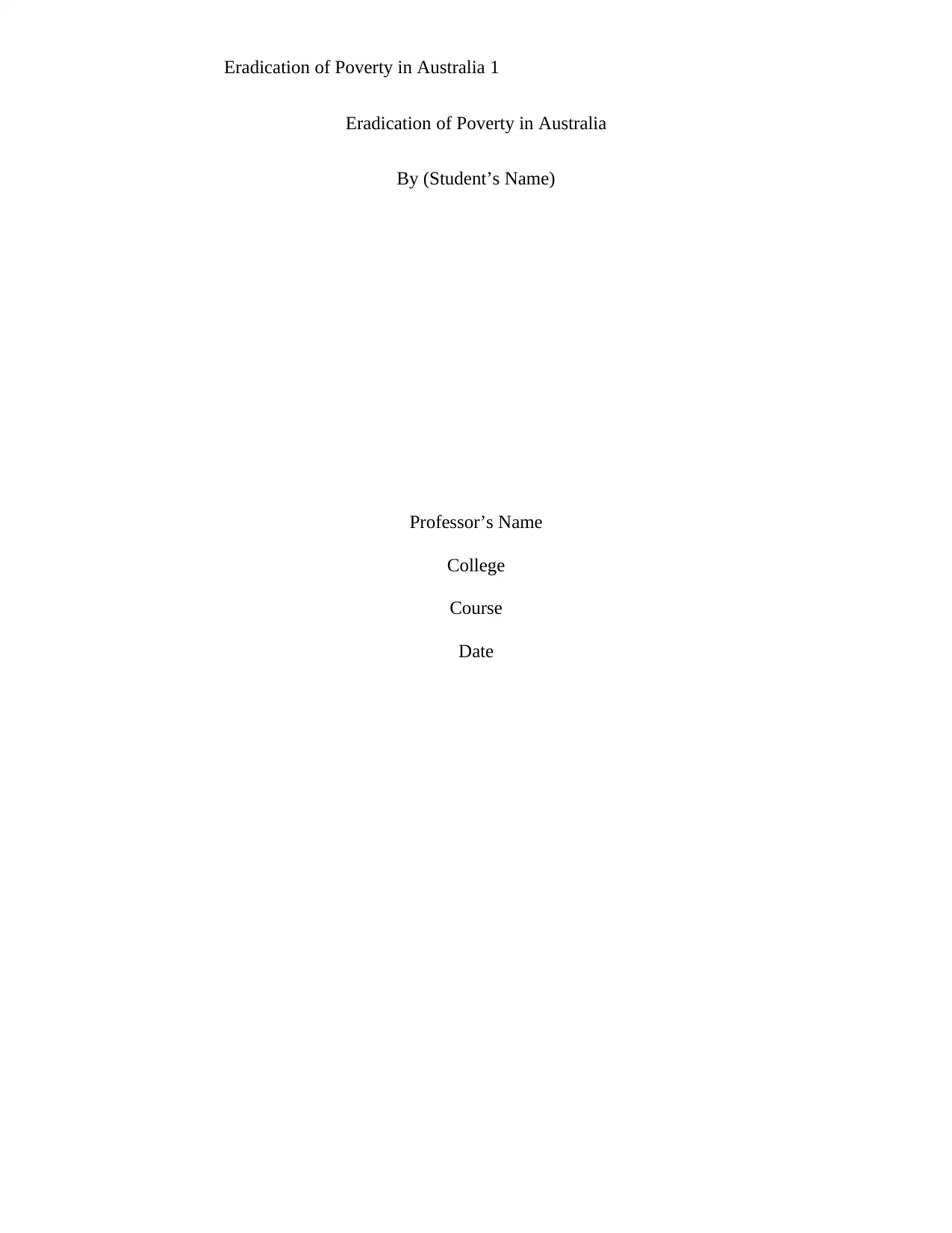
Eradication of Poverty in Australia 1
Eradication of Poverty in Australia
By (Student’s Name)
Professor’s Name
College
Course
Date
Eradication of Poverty in Australia
By (Student’s Name)
Professor’s Name
College
Course
Date
Paraphrase This Document
Need a fresh take? Get an instant paraphrase of this document with our AI Paraphraser
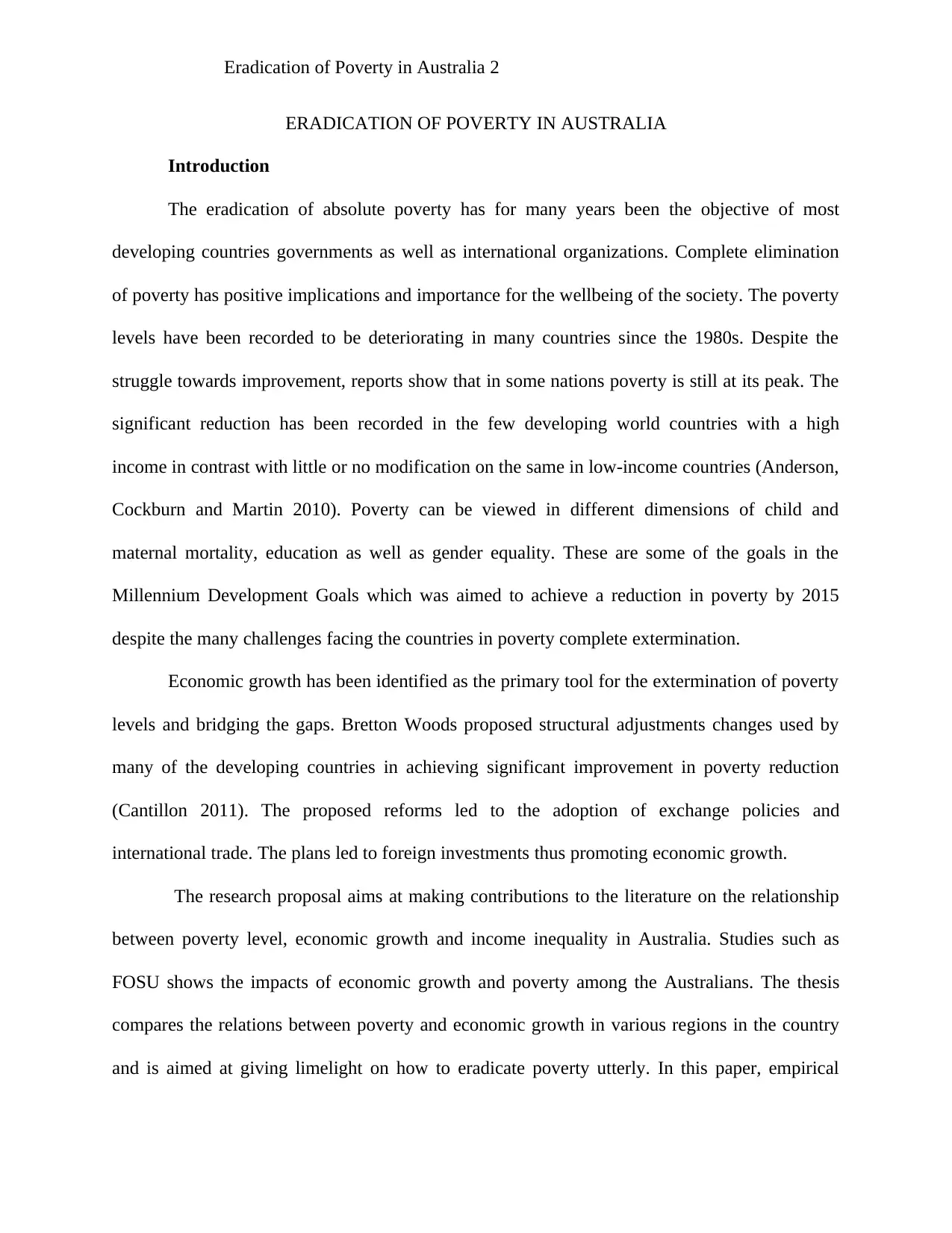
Eradication of Poverty in Australia 2
ERADICATION OF POVERTY IN AUSTRALIA
Introduction
The eradication of absolute poverty has for many years been the objective of most
developing countries governments as well as international organizations. Complete elimination
of poverty has positive implications and importance for the wellbeing of the society. The poverty
levels have been recorded to be deteriorating in many countries since the 1980s. Despite the
struggle towards improvement, reports show that in some nations poverty is still at its peak. The
significant reduction has been recorded in the few developing world countries with a high
income in contrast with little or no modification on the same in low-income countries (Anderson,
Cockburn and Martin 2010). Poverty can be viewed in different dimensions of child and
maternal mortality, education as well as gender equality. These are some of the goals in the
Millennium Development Goals which was aimed to achieve a reduction in poverty by 2015
despite the many challenges facing the countries in poverty complete extermination.
Economic growth has been identified as the primary tool for the extermination of poverty
levels and bridging the gaps. Bretton Woods proposed structural adjustments changes used by
many of the developing countries in achieving significant improvement in poverty reduction
(Cantillon 2011). The proposed reforms led to the adoption of exchange policies and
international trade. The plans led to foreign investments thus promoting economic growth.
The research proposal aims at making contributions to the literature on the relationship
between poverty level, economic growth and income inequality in Australia. Studies such as
FOSU shows the impacts of economic growth and poverty among the Australians. The thesis
compares the relations between poverty and economic growth in various regions in the country
and is aimed at giving limelight on how to eradicate poverty utterly. In this paper, empirical
ERADICATION OF POVERTY IN AUSTRALIA
Introduction
The eradication of absolute poverty has for many years been the objective of most
developing countries governments as well as international organizations. Complete elimination
of poverty has positive implications and importance for the wellbeing of the society. The poverty
levels have been recorded to be deteriorating in many countries since the 1980s. Despite the
struggle towards improvement, reports show that in some nations poverty is still at its peak. The
significant reduction has been recorded in the few developing world countries with a high
income in contrast with little or no modification on the same in low-income countries (Anderson,
Cockburn and Martin 2010). Poverty can be viewed in different dimensions of child and
maternal mortality, education as well as gender equality. These are some of the goals in the
Millennium Development Goals which was aimed to achieve a reduction in poverty by 2015
despite the many challenges facing the countries in poverty complete extermination.
Economic growth has been identified as the primary tool for the extermination of poverty
levels and bridging the gaps. Bretton Woods proposed structural adjustments changes used by
many of the developing countries in achieving significant improvement in poverty reduction
(Cantillon 2011). The proposed reforms led to the adoption of exchange policies and
international trade. The plans led to foreign investments thus promoting economic growth.
The research proposal aims at making contributions to the literature on the relationship
between poverty level, economic growth and income inequality in Australia. Studies such as
FOSU shows the impacts of economic growth and poverty among the Australians. The thesis
compares the relations between poverty and economic growth in various regions in the country
and is aimed at giving limelight on how to eradicate poverty utterly. In this paper, empirical
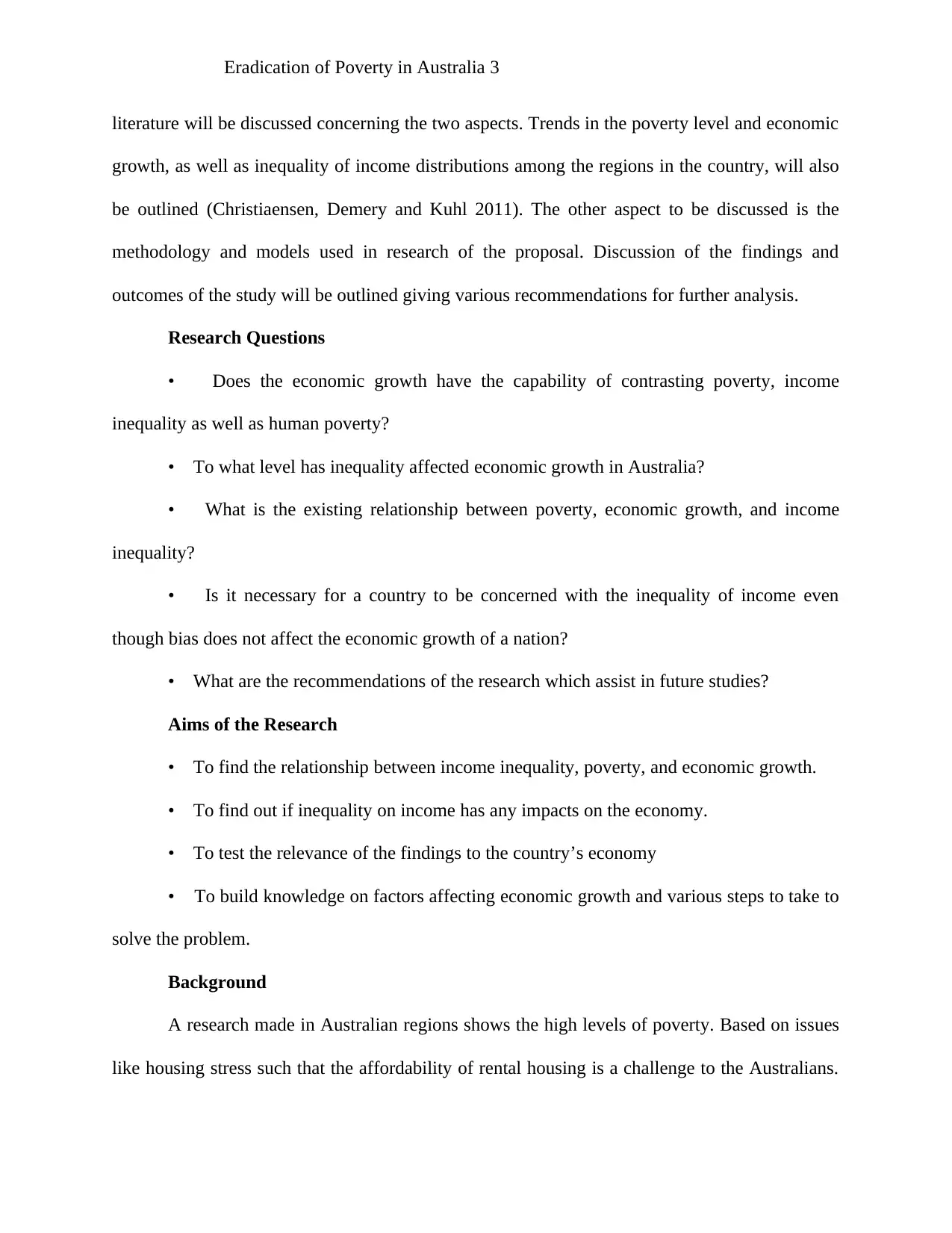
Eradication of Poverty in Australia 3
literature will be discussed concerning the two aspects. Trends in the poverty level and economic
growth, as well as inequality of income distributions among the regions in the country, will also
be outlined (Christiaensen, Demery and Kuhl 2011). The other aspect to be discussed is the
methodology and models used in research of the proposal. Discussion of the findings and
outcomes of the study will be outlined giving various recommendations for further analysis.
Research Questions
• Does the economic growth have the capability of contrasting poverty, income
inequality as well as human poverty?
• To what level has inequality affected economic growth in Australia?
• What is the existing relationship between poverty, economic growth, and income
inequality?
• Is it necessary for a country to be concerned with the inequality of income even
though bias does not affect the economic growth of a nation?
• What are the recommendations of the research which assist in future studies?
Aims of the Research
• To find the relationship between income inequality, poverty, and economic growth.
• To find out if inequality on income has any impacts on the economy.
• To test the relevance of the findings to the country’s economy
• To build knowledge on factors affecting economic growth and various steps to take to
solve the problem.
Background
A research made in Australian regions shows the high levels of poverty. Based on issues
like housing stress such that the affordability of rental housing is a challenge to the Australians.
literature will be discussed concerning the two aspects. Trends in the poverty level and economic
growth, as well as inequality of income distributions among the regions in the country, will also
be outlined (Christiaensen, Demery and Kuhl 2011). The other aspect to be discussed is the
methodology and models used in research of the proposal. Discussion of the findings and
outcomes of the study will be outlined giving various recommendations for further analysis.
Research Questions
• Does the economic growth have the capability of contrasting poverty, income
inequality as well as human poverty?
• To what level has inequality affected economic growth in Australia?
• What is the existing relationship between poverty, economic growth, and income
inequality?
• Is it necessary for a country to be concerned with the inequality of income even
though bias does not affect the economic growth of a nation?
• What are the recommendations of the research which assist in future studies?
Aims of the Research
• To find the relationship between income inequality, poverty, and economic growth.
• To find out if inequality on income has any impacts on the economy.
• To test the relevance of the findings to the country’s economy
• To build knowledge on factors affecting economic growth and various steps to take to
solve the problem.
Background
A research made in Australian regions shows the high levels of poverty. Based on issues
like housing stress such that the affordability of rental housing is a challenge to the Australians.
⊘ This is a preview!⊘
Do you want full access?
Subscribe today to unlock all pages.

Trusted by 1+ million students worldwide
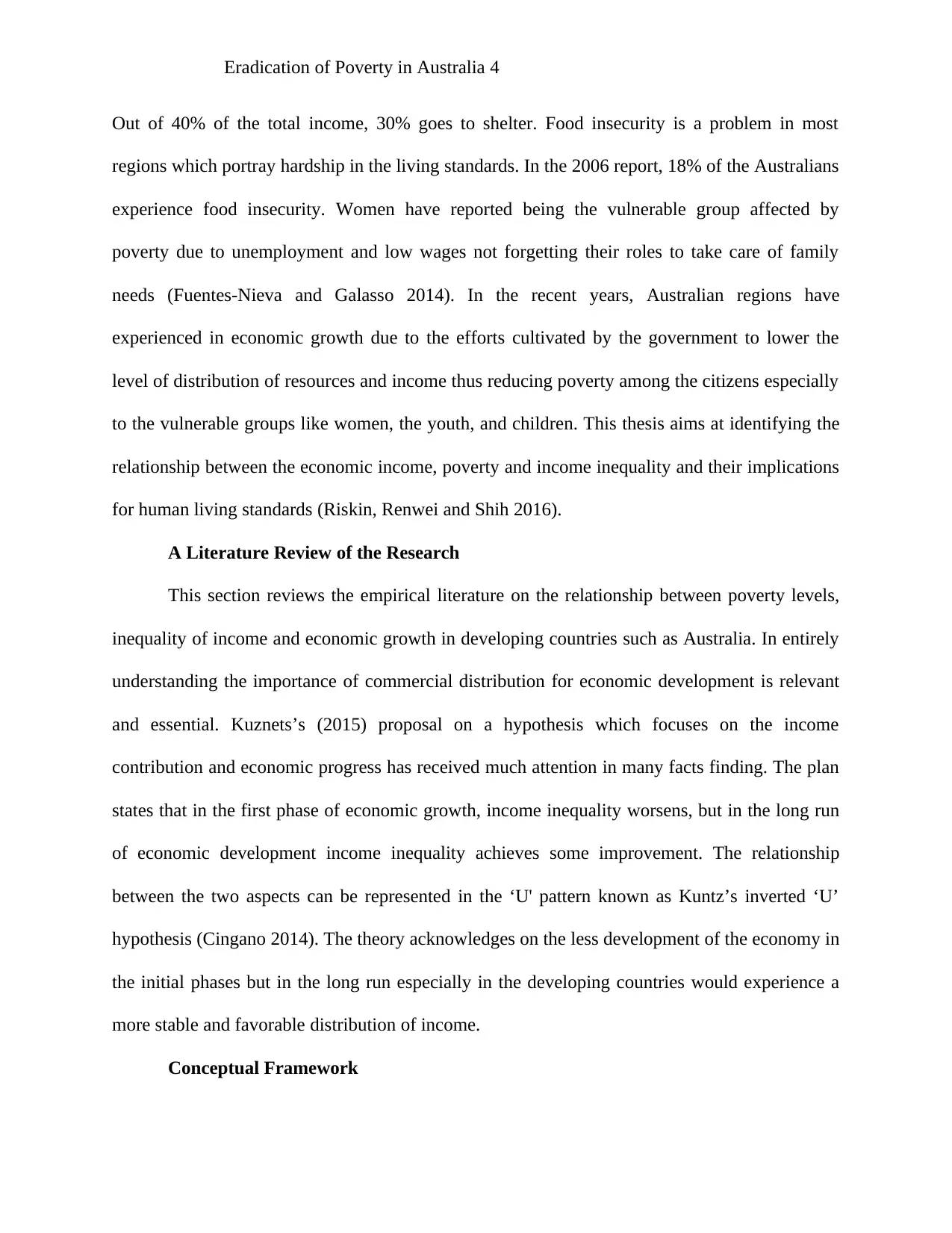
Eradication of Poverty in Australia 4
Out of 40% of the total income, 30% goes to shelter. Food insecurity is a problem in most
regions which portray hardship in the living standards. In the 2006 report, 18% of the Australians
experience food insecurity. Women have reported being the vulnerable group affected by
poverty due to unemployment and low wages not forgetting their roles to take care of family
needs (Fuentes-Nieva and Galasso 2014). In the recent years, Australian regions have
experienced in economic growth due to the efforts cultivated by the government to lower the
level of distribution of resources and income thus reducing poverty among the citizens especially
to the vulnerable groups like women, the youth, and children. This thesis aims at identifying the
relationship between the economic income, poverty and income inequality and their implications
for human living standards (Riskin, Renwei and Shih 2016).
A Literature Review of the Research
This section reviews the empirical literature on the relationship between poverty levels,
inequality of income and economic growth in developing countries such as Australia. In entirely
understanding the importance of commercial distribution for economic development is relevant
and essential. Kuznets’s (2015) proposal on a hypothesis which focuses on the income
contribution and economic progress has received much attention in many facts finding. The plan
states that in the first phase of economic growth, income inequality worsens, but in the long run
of economic development income inequality achieves some improvement. The relationship
between the two aspects can be represented in the ‘U' pattern known as Kuntz’s inverted ‘U’
hypothesis (Cingano 2014). The theory acknowledges on the less development of the economy in
the initial phases but in the long run especially in the developing countries would experience a
more stable and favorable distribution of income.
Conceptual Framework
Out of 40% of the total income, 30% goes to shelter. Food insecurity is a problem in most
regions which portray hardship in the living standards. In the 2006 report, 18% of the Australians
experience food insecurity. Women have reported being the vulnerable group affected by
poverty due to unemployment and low wages not forgetting their roles to take care of family
needs (Fuentes-Nieva and Galasso 2014). In the recent years, Australian regions have
experienced in economic growth due to the efforts cultivated by the government to lower the
level of distribution of resources and income thus reducing poverty among the citizens especially
to the vulnerable groups like women, the youth, and children. This thesis aims at identifying the
relationship between the economic income, poverty and income inequality and their implications
for human living standards (Riskin, Renwei and Shih 2016).
A Literature Review of the Research
This section reviews the empirical literature on the relationship between poverty levels,
inequality of income and economic growth in developing countries such as Australia. In entirely
understanding the importance of commercial distribution for economic development is relevant
and essential. Kuznets’s (2015) proposal on a hypothesis which focuses on the income
contribution and economic progress has received much attention in many facts finding. The plan
states that in the first phase of economic growth, income inequality worsens, but in the long run
of economic development income inequality achieves some improvement. The relationship
between the two aspects can be represented in the ‘U' pattern known as Kuntz’s inverted ‘U’
hypothesis (Cingano 2014). The theory acknowledges on the less development of the economy in
the initial phases but in the long run especially in the developing countries would experience a
more stable and favorable distribution of income.
Conceptual Framework
Paraphrase This Document
Need a fresh take? Get an instant paraphrase of this document with our AI Paraphraser
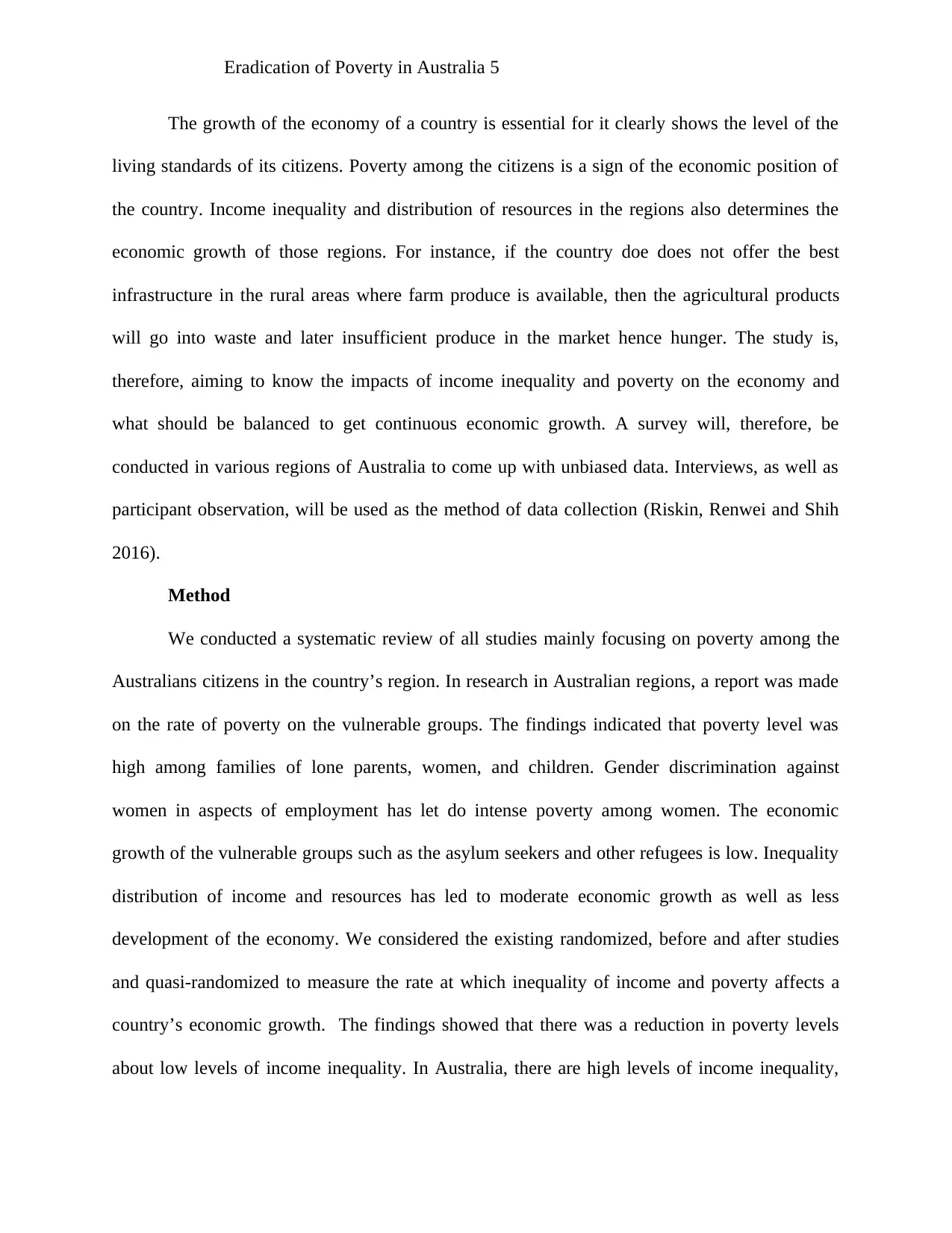
Eradication of Poverty in Australia 5
The growth of the economy of a country is essential for it clearly shows the level of the
living standards of its citizens. Poverty among the citizens is a sign of the economic position of
the country. Income inequality and distribution of resources in the regions also determines the
economic growth of those regions. For instance, if the country doe does not offer the best
infrastructure in the rural areas where farm produce is available, then the agricultural products
will go into waste and later insufficient produce in the market hence hunger. The study is,
therefore, aiming to know the impacts of income inequality and poverty on the economy and
what should be balanced to get continuous economic growth. A survey will, therefore, be
conducted in various regions of Australia to come up with unbiased data. Interviews, as well as
participant observation, will be used as the method of data collection (Riskin, Renwei and Shih
2016).
Method
We conducted a systematic review of all studies mainly focusing on poverty among the
Australians citizens in the country’s region. In research in Australian regions, a report was made
on the rate of poverty on the vulnerable groups. The findings indicated that poverty level was
high among families of lone parents, women, and children. Gender discrimination against
women in aspects of employment has let do intense poverty among women. The economic
growth of the vulnerable groups such as the asylum seekers and other refugees is low. Inequality
distribution of income and resources has led to moderate economic growth as well as less
development of the economy. We considered the existing randomized, before and after studies
and quasi-randomized to measure the rate at which inequality of income and poverty affects a
country’s economic growth. The findings showed that there was a reduction in poverty levels
about low levels of income inequality. In Australia, there are high levels of income inequality,
The growth of the economy of a country is essential for it clearly shows the level of the
living standards of its citizens. Poverty among the citizens is a sign of the economic position of
the country. Income inequality and distribution of resources in the regions also determines the
economic growth of those regions. For instance, if the country doe does not offer the best
infrastructure in the rural areas where farm produce is available, then the agricultural products
will go into waste and later insufficient produce in the market hence hunger. The study is,
therefore, aiming to know the impacts of income inequality and poverty on the economy and
what should be balanced to get continuous economic growth. A survey will, therefore, be
conducted in various regions of Australia to come up with unbiased data. Interviews, as well as
participant observation, will be used as the method of data collection (Riskin, Renwei and Shih
2016).
Method
We conducted a systematic review of all studies mainly focusing on poverty among the
Australians citizens in the country’s region. In research in Australian regions, a report was made
on the rate of poverty on the vulnerable groups. The findings indicated that poverty level was
high among families of lone parents, women, and children. Gender discrimination against
women in aspects of employment has let do intense poverty among women. The economic
growth of the vulnerable groups such as the asylum seekers and other refugees is low. Inequality
distribution of income and resources has led to moderate economic growth as well as less
development of the economy. We considered the existing randomized, before and after studies
and quasi-randomized to measure the rate at which inequality of income and poverty affects a
country’s economic growth. The findings showed that there was a reduction in poverty levels
about low levels of income inequality. In Australia, there are high levels of income inequality,
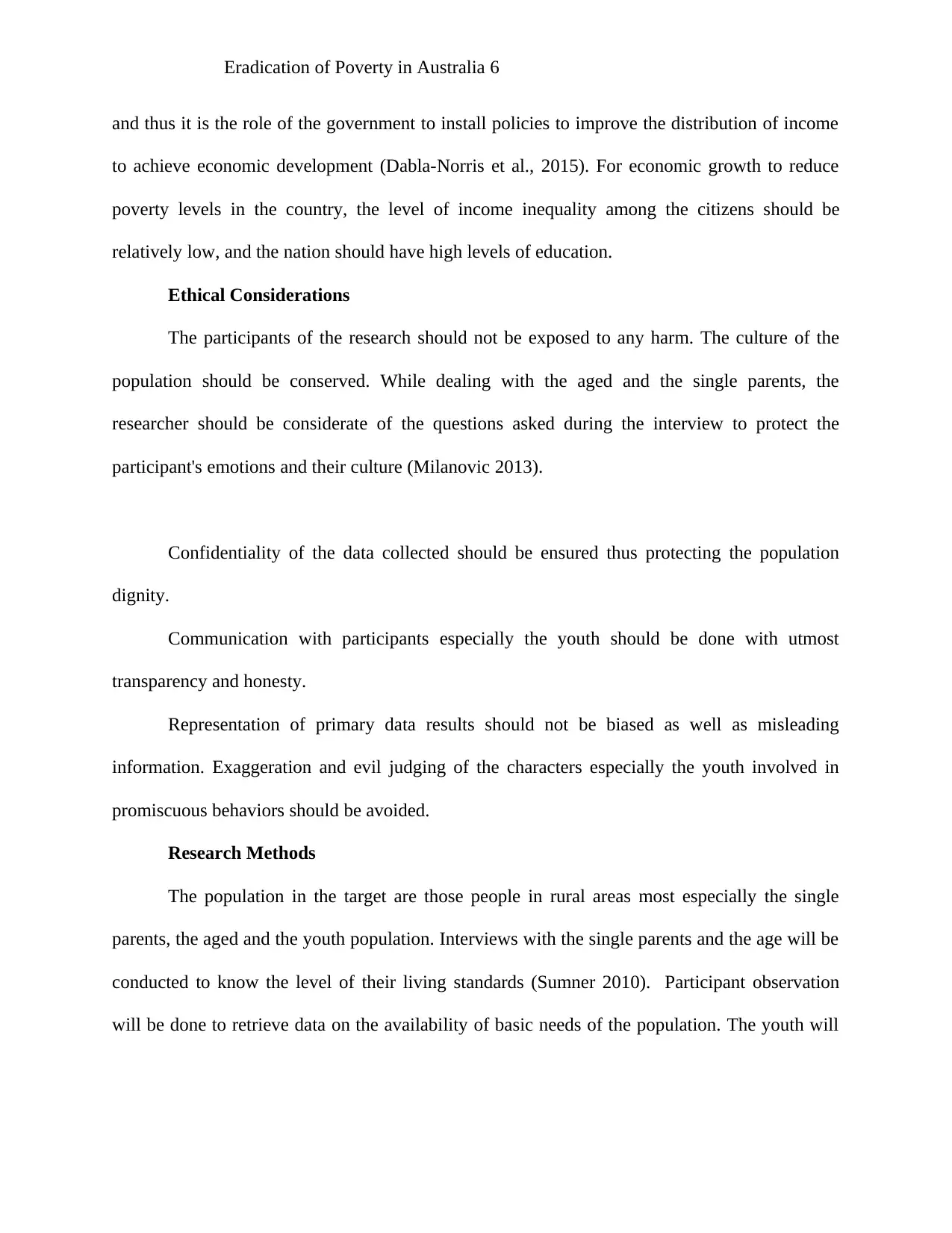
Eradication of Poverty in Australia 6
and thus it is the role of the government to install policies to improve the distribution of income
to achieve economic development (Dabla-Norris et al., 2015). For economic growth to reduce
poverty levels in the country, the level of income inequality among the citizens should be
relatively low, and the nation should have high levels of education.
Ethical Considerations
The participants of the research should not be exposed to any harm. The culture of the
population should be conserved. While dealing with the aged and the single parents, the
researcher should be considerate of the questions asked during the interview to protect the
participant's emotions and their culture (Milanovic 2013).
Confidentiality of the data collected should be ensured thus protecting the population
dignity.
Communication with participants especially the youth should be done with utmost
transparency and honesty.
Representation of primary data results should not be biased as well as misleading
information. Exaggeration and evil judging of the characters especially the youth involved in
promiscuous behaviors should be avoided.
Research Methods
The population in the target are those people in rural areas most especially the single
parents, the aged and the youth population. Interviews with the single parents and the age will be
conducted to know the level of their living standards (Sumner 2010). Participant observation
will be done to retrieve data on the availability of basic needs of the population. The youth will
and thus it is the role of the government to install policies to improve the distribution of income
to achieve economic development (Dabla-Norris et al., 2015). For economic growth to reduce
poverty levels in the country, the level of income inequality among the citizens should be
relatively low, and the nation should have high levels of education.
Ethical Considerations
The participants of the research should not be exposed to any harm. The culture of the
population should be conserved. While dealing with the aged and the single parents, the
researcher should be considerate of the questions asked during the interview to protect the
participant's emotions and their culture (Milanovic 2013).
Confidentiality of the data collected should be ensured thus protecting the population
dignity.
Communication with participants especially the youth should be done with utmost
transparency and honesty.
Representation of primary data results should not be biased as well as misleading
information. Exaggeration and evil judging of the characters especially the youth involved in
promiscuous behaviors should be avoided.
Research Methods
The population in the target are those people in rural areas most especially the single
parents, the aged and the youth population. Interviews with the single parents and the age will be
conducted to know the level of their living standards (Sumner 2010). Participant observation
will be done to retrieve data on the availability of basic needs of the population. The youth will
⊘ This is a preview!⊘
Do you want full access?
Subscribe today to unlock all pages.

Trusted by 1+ million students worldwide
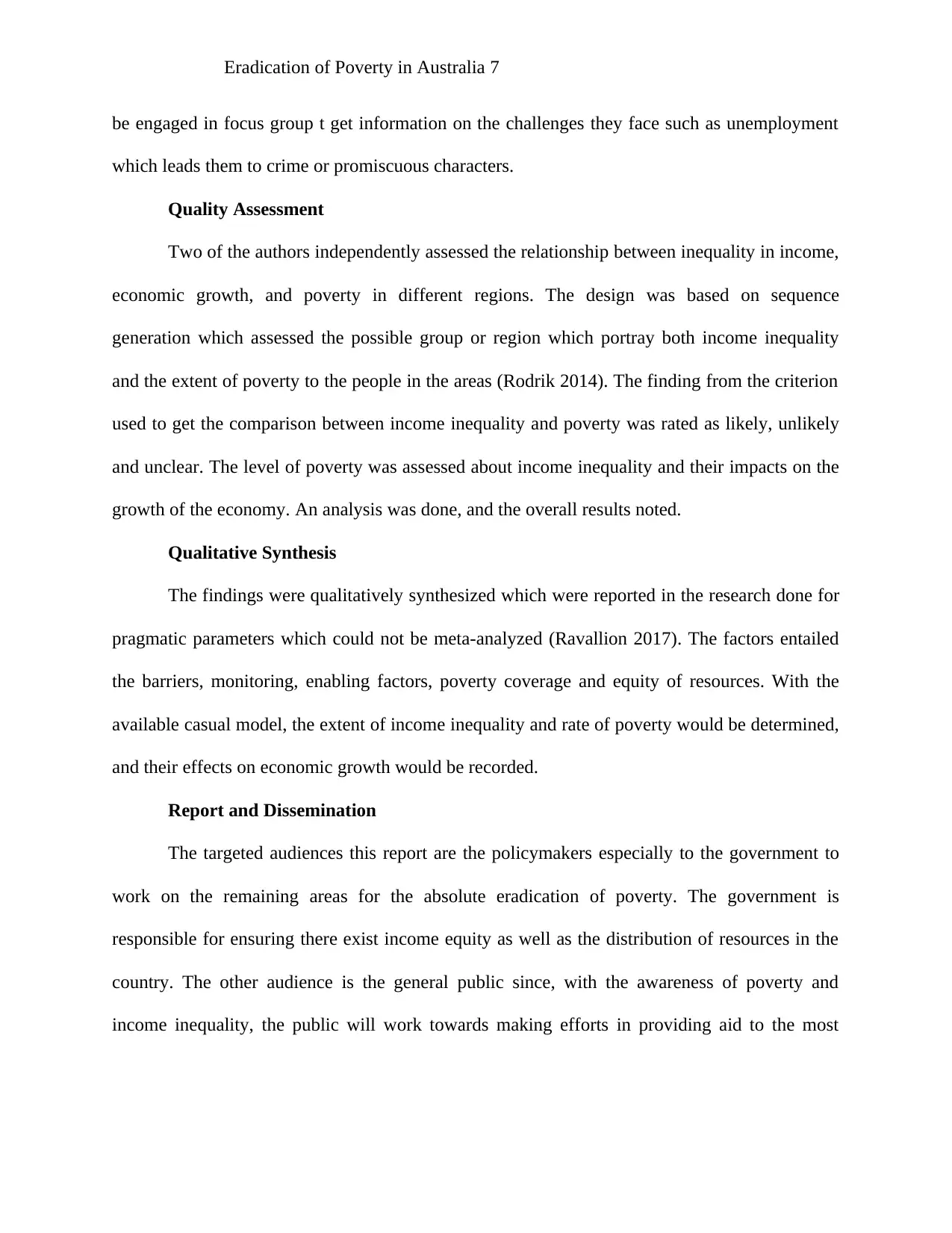
Eradication of Poverty in Australia 7
be engaged in focus group t get information on the challenges they face such as unemployment
which leads them to crime or promiscuous characters.
Quality Assessment
Two of the authors independently assessed the relationship between inequality in income,
economic growth, and poverty in different regions. The design was based on sequence
generation which assessed the possible group or region which portray both income inequality
and the extent of poverty to the people in the areas (Rodrik 2014). The finding from the criterion
used to get the comparison between income inequality and poverty was rated as likely, unlikely
and unclear. The level of poverty was assessed about income inequality and their impacts on the
growth of the economy. An analysis was done, and the overall results noted.
Qualitative Synthesis
The findings were qualitatively synthesized which were reported in the research done for
pragmatic parameters which could not be meta-analyzed (Ravallion 2017). The factors entailed
the barriers, monitoring, enabling factors, poverty coverage and equity of resources. With the
available casual model, the extent of income inequality and rate of poverty would be determined,
and their effects on economic growth would be recorded.
Report and Dissemination
The targeted audiences this report are the policymakers especially to the government to
work on the remaining areas for the absolute eradication of poverty. The government is
responsible for ensuring there exist income equity as well as the distribution of resources in the
country. The other audience is the general public since, with the awareness of poverty and
income inequality, the public will work towards making efforts in providing aid to the most
be engaged in focus group t get information on the challenges they face such as unemployment
which leads them to crime or promiscuous characters.
Quality Assessment
Two of the authors independently assessed the relationship between inequality in income,
economic growth, and poverty in different regions. The design was based on sequence
generation which assessed the possible group or region which portray both income inequality
and the extent of poverty to the people in the areas (Rodrik 2014). The finding from the criterion
used to get the comparison between income inequality and poverty was rated as likely, unlikely
and unclear. The level of poverty was assessed about income inequality and their impacts on the
growth of the economy. An analysis was done, and the overall results noted.
Qualitative Synthesis
The findings were qualitatively synthesized which were reported in the research done for
pragmatic parameters which could not be meta-analyzed (Ravallion 2017). The factors entailed
the barriers, monitoring, enabling factors, poverty coverage and equity of resources. With the
available casual model, the extent of income inequality and rate of poverty would be determined,
and their effects on economic growth would be recorded.
Report and Dissemination
The targeted audiences this report are the policymakers especially to the government to
work on the remaining areas for the absolute eradication of poverty. The government is
responsible for ensuring there exist income equity as well as the distribution of resources in the
country. The other audience is the general public since, with the awareness of poverty and
income inequality, the public will work towards making efforts in providing aid to the most
Paraphrase This Document
Need a fresh take? Get an instant paraphrase of this document with our AI Paraphraser
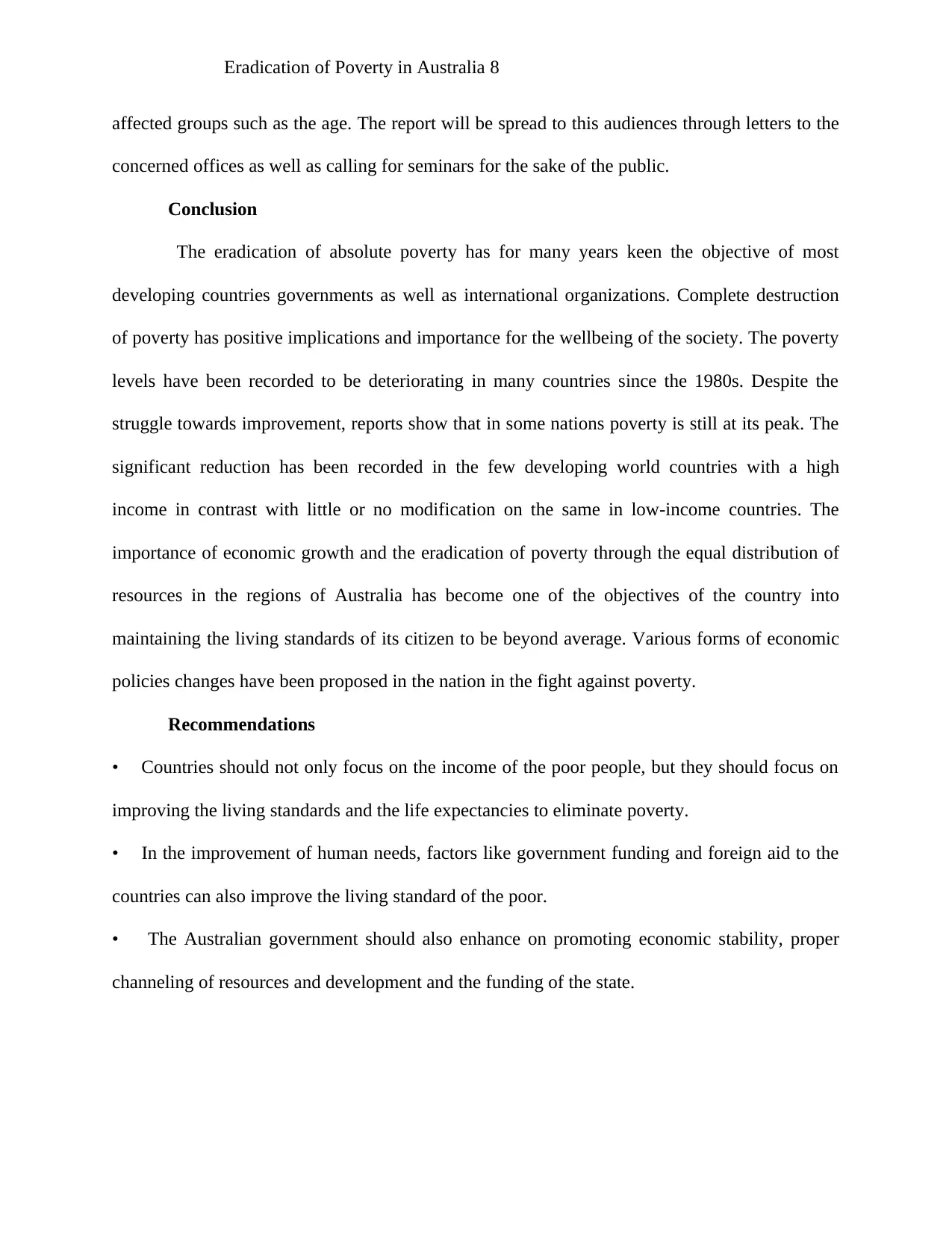
Eradication of Poverty in Australia 8
affected groups such as the age. The report will be spread to this audiences through letters to the
concerned offices as well as calling for seminars for the sake of the public.
Conclusion
The eradication of absolute poverty has for many years keen the objective of most
developing countries governments as well as international organizations. Complete destruction
of poverty has positive implications and importance for the wellbeing of the society. The poverty
levels have been recorded to be deteriorating in many countries since the 1980s. Despite the
struggle towards improvement, reports show that in some nations poverty is still at its peak. The
significant reduction has been recorded in the few developing world countries with a high
income in contrast with little or no modification on the same in low-income countries. The
importance of economic growth and the eradication of poverty through the equal distribution of
resources in the regions of Australia has become one of the objectives of the country into
maintaining the living standards of its citizen to be beyond average. Various forms of economic
policies changes have been proposed in the nation in the fight against poverty.
Recommendations
• Countries should not only focus on the income of the poor people, but they should focus on
improving the living standards and the life expectancies to eliminate poverty.
• In the improvement of human needs, factors like government funding and foreign aid to the
countries can also improve the living standard of the poor.
• The Australian government should also enhance on promoting economic stability, proper
channeling of resources and development and the funding of the state.
affected groups such as the age. The report will be spread to this audiences through letters to the
concerned offices as well as calling for seminars for the sake of the public.
Conclusion
The eradication of absolute poverty has for many years keen the objective of most
developing countries governments as well as international organizations. Complete destruction
of poverty has positive implications and importance for the wellbeing of the society. The poverty
levels have been recorded to be deteriorating in many countries since the 1980s. Despite the
struggle towards improvement, reports show that in some nations poverty is still at its peak. The
significant reduction has been recorded in the few developing world countries with a high
income in contrast with little or no modification on the same in low-income countries. The
importance of economic growth and the eradication of poverty through the equal distribution of
resources in the regions of Australia has become one of the objectives of the country into
maintaining the living standards of its citizen to be beyond average. Various forms of economic
policies changes have been proposed in the nation in the fight against poverty.
Recommendations
• Countries should not only focus on the income of the poor people, but they should focus on
improving the living standards and the life expectancies to eliminate poverty.
• In the improvement of human needs, factors like government funding and foreign aid to the
countries can also improve the living standard of the poor.
• The Australian government should also enhance on promoting economic stability, proper
channeling of resources and development and the funding of the state.
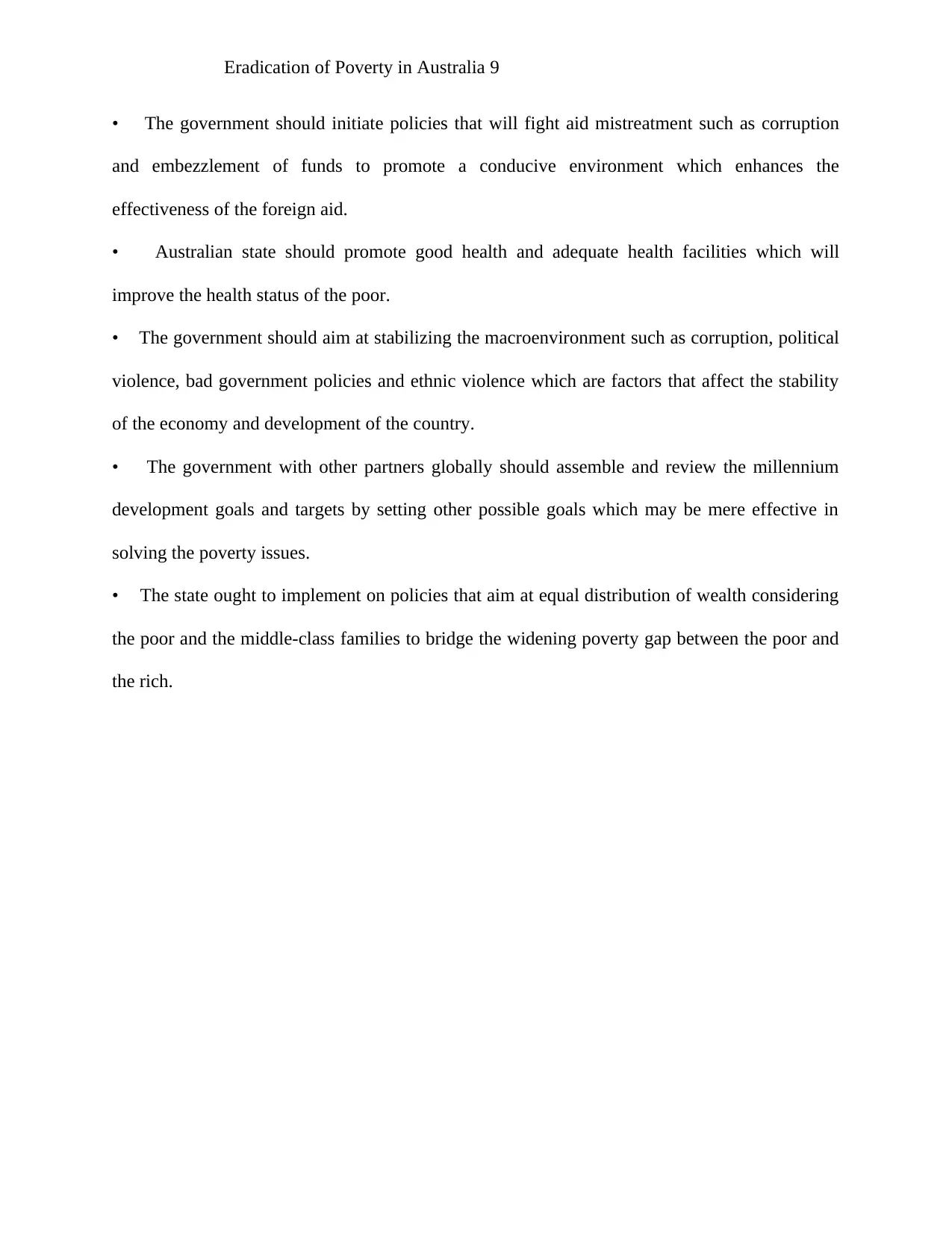
Eradication of Poverty in Australia 9
• The government should initiate policies that will fight aid mistreatment such as corruption
and embezzlement of funds to promote a conducive environment which enhances the
effectiveness of the foreign aid.
• Australian state should promote good health and adequate health facilities which will
improve the health status of the poor.
• The government should aim at stabilizing the macroenvironment such as corruption, political
violence, bad government policies and ethnic violence which are factors that affect the stability
of the economy and development of the country.
• The government with other partners globally should assemble and review the millennium
development goals and targets by setting other possible goals which may be mere effective in
solving the poverty issues.
• The state ought to implement on policies that aim at equal distribution of wealth considering
the poor and the middle-class families to bridge the widening poverty gap between the poor and
the rich.
• The government should initiate policies that will fight aid mistreatment such as corruption
and embezzlement of funds to promote a conducive environment which enhances the
effectiveness of the foreign aid.
• Australian state should promote good health and adequate health facilities which will
improve the health status of the poor.
• The government should aim at stabilizing the macroenvironment such as corruption, political
violence, bad government policies and ethnic violence which are factors that affect the stability
of the economy and development of the country.
• The government with other partners globally should assemble and review the millennium
development goals and targets by setting other possible goals which may be mere effective in
solving the poverty issues.
• The state ought to implement on policies that aim at equal distribution of wealth considering
the poor and the middle-class families to bridge the widening poverty gap between the poor and
the rich.
⊘ This is a preview!⊘
Do you want full access?
Subscribe today to unlock all pages.

Trusted by 1+ million students worldwide
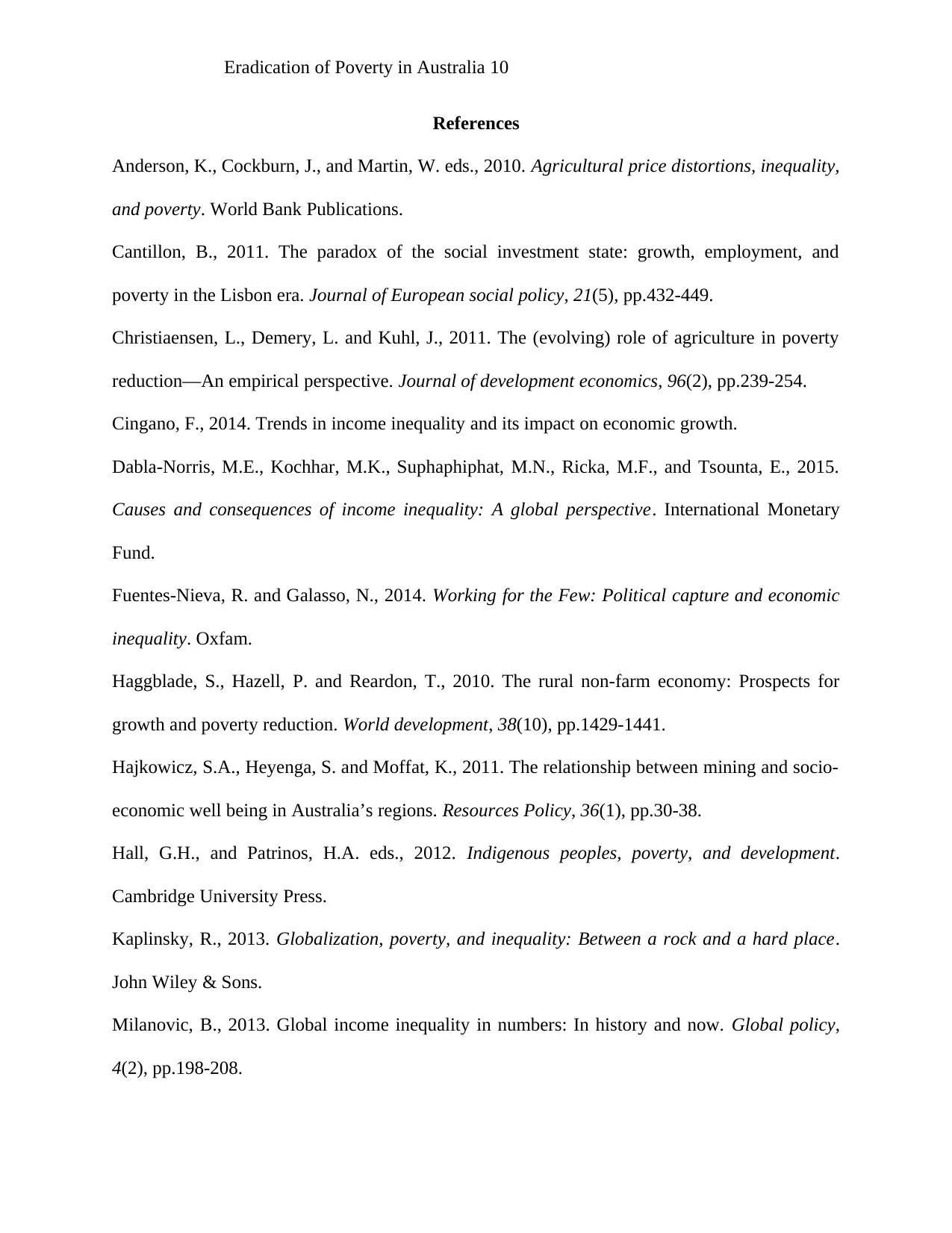
Eradication of Poverty in Australia 10
References
Anderson, K., Cockburn, J., and Martin, W. eds., 2010. Agricultural price distortions, inequality,
and poverty. World Bank Publications.
Cantillon, B., 2011. The paradox of the social investment state: growth, employment, and
poverty in the Lisbon era. Journal of European social policy, 21(5), pp.432-449.
Christiaensen, L., Demery, L. and Kuhl, J., 2011. The (evolving) role of agriculture in poverty
reduction—An empirical perspective. Journal of development economics, 96(2), pp.239-254.
Cingano, F., 2014. Trends in income inequality and its impact on economic growth.
Dabla-Norris, M.E., Kochhar, M.K., Suphaphiphat, M.N., Ricka, M.F., and Tsounta, E., 2015.
Causes and consequences of income inequality: A global perspective. International Monetary
Fund.
Fuentes-Nieva, R. and Galasso, N., 2014. Working for the Few: Political capture and economic
inequality. Oxfam.
Haggblade, S., Hazell, P. and Reardon, T., 2010. The rural non-farm economy: Prospects for
growth and poverty reduction. World development, 38(10), pp.1429-1441.
Hajkowicz, S.A., Heyenga, S. and Moffat, K., 2011. The relationship between mining and socio-
economic well being in Australia’s regions. Resources Policy, 36(1), pp.30-38.
Hall, G.H., and Patrinos, H.A. eds., 2012. Indigenous peoples, poverty, and development.
Cambridge University Press.
Kaplinsky, R., 2013. Globalization, poverty, and inequality: Between a rock and a hard place.
John Wiley & Sons.
Milanovic, B., 2013. Global income inequality in numbers: In history and now. Global policy,
4(2), pp.198-208.
References
Anderson, K., Cockburn, J., and Martin, W. eds., 2010. Agricultural price distortions, inequality,
and poverty. World Bank Publications.
Cantillon, B., 2011. The paradox of the social investment state: growth, employment, and
poverty in the Lisbon era. Journal of European social policy, 21(5), pp.432-449.
Christiaensen, L., Demery, L. and Kuhl, J., 2011. The (evolving) role of agriculture in poverty
reduction—An empirical perspective. Journal of development economics, 96(2), pp.239-254.
Cingano, F., 2014. Trends in income inequality and its impact on economic growth.
Dabla-Norris, M.E., Kochhar, M.K., Suphaphiphat, M.N., Ricka, M.F., and Tsounta, E., 2015.
Causes and consequences of income inequality: A global perspective. International Monetary
Fund.
Fuentes-Nieva, R. and Galasso, N., 2014. Working for the Few: Political capture and economic
inequality. Oxfam.
Haggblade, S., Hazell, P. and Reardon, T., 2010. The rural non-farm economy: Prospects for
growth and poverty reduction. World development, 38(10), pp.1429-1441.
Hajkowicz, S.A., Heyenga, S. and Moffat, K., 2011. The relationship between mining and socio-
economic well being in Australia’s regions. Resources Policy, 36(1), pp.30-38.
Hall, G.H., and Patrinos, H.A. eds., 2012. Indigenous peoples, poverty, and development.
Cambridge University Press.
Kaplinsky, R., 2013. Globalization, poverty, and inequality: Between a rock and a hard place.
John Wiley & Sons.
Milanovic, B., 2013. Global income inequality in numbers: In history and now. Global policy,
4(2), pp.198-208.
Paraphrase This Document
Need a fresh take? Get an instant paraphrase of this document with our AI Paraphraser
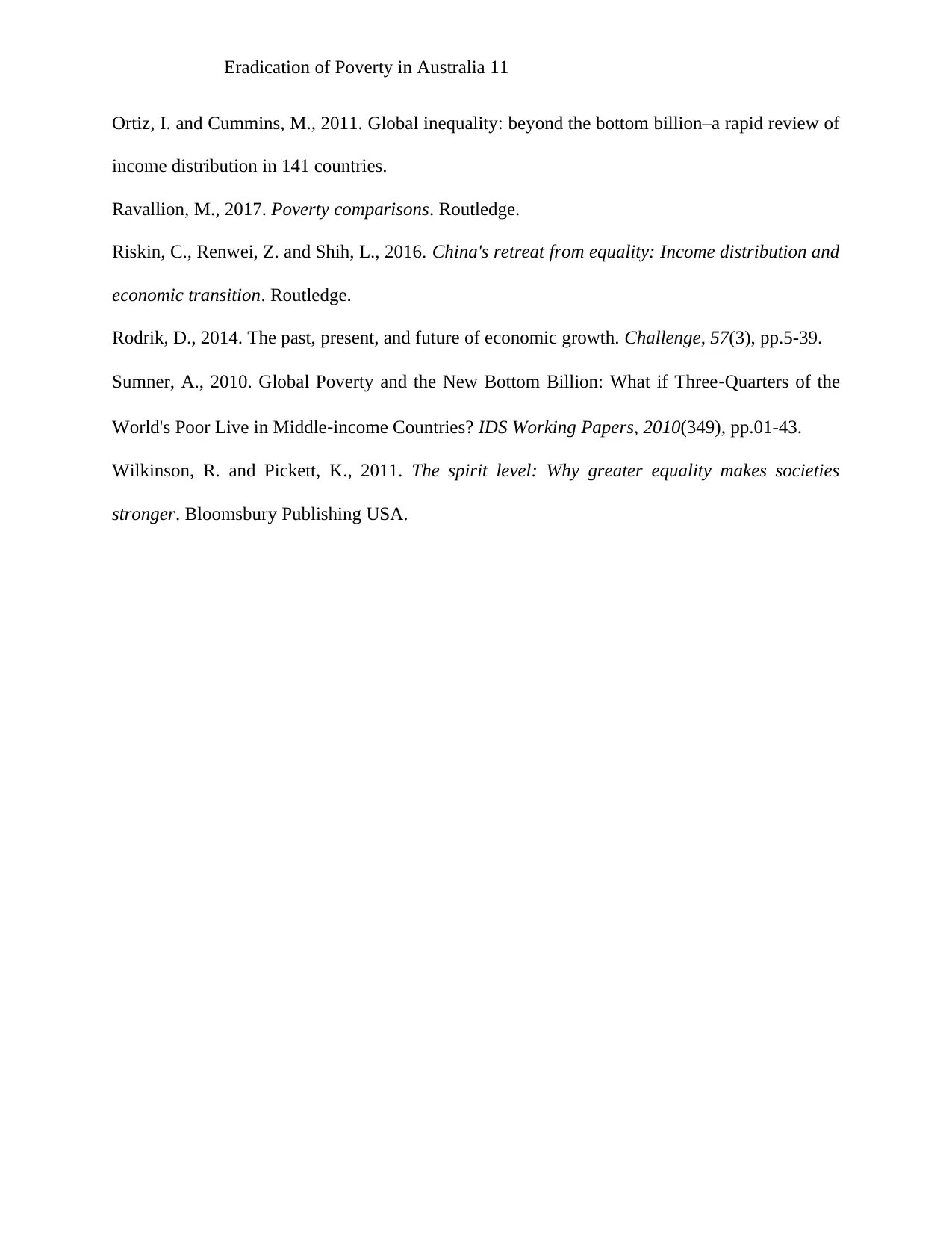
Eradication of Poverty in Australia 11
Ortiz, I. and Cummins, M., 2011. Global inequality: beyond the bottom billion–a rapid review of
income distribution in 141 countries.
Ravallion, M., 2017. Poverty comparisons. Routledge.
Riskin, C., Renwei, Z. and Shih, L., 2016. China's retreat from equality: Income distribution and
economic transition. Routledge.
Rodrik, D., 2014. The past, present, and future of economic growth. Challenge, 57(3), pp.5-39.
Sumner, A., 2010. Global Poverty and the New Bottom Billion: What if Three‐Quarters of the
World's Poor Live in Middle‐income Countries? IDS Working Papers, 2010(349), pp.01-43.
Wilkinson, R. and Pickett, K., 2011. The spirit level: Why greater equality makes societies
stronger. Bloomsbury Publishing USA.
Ortiz, I. and Cummins, M., 2011. Global inequality: beyond the bottom billion–a rapid review of
income distribution in 141 countries.
Ravallion, M., 2017. Poverty comparisons. Routledge.
Riskin, C., Renwei, Z. and Shih, L., 2016. China's retreat from equality: Income distribution and
economic transition. Routledge.
Rodrik, D., 2014. The past, present, and future of economic growth. Challenge, 57(3), pp.5-39.
Sumner, A., 2010. Global Poverty and the New Bottom Billion: What if Three‐Quarters of the
World's Poor Live in Middle‐income Countries? IDS Working Papers, 2010(349), pp.01-43.
Wilkinson, R. and Pickett, K., 2011. The spirit level: Why greater equality makes societies
stronger. Bloomsbury Publishing USA.
1 out of 11
Related Documents
Your All-in-One AI-Powered Toolkit for Academic Success.
+13062052269
info@desklib.com
Available 24*7 on WhatsApp / Email
![[object Object]](/_next/static/media/star-bottom.7253800d.svg)
Unlock your academic potential
Copyright © 2020–2025 A2Z Services. All Rights Reserved. Developed and managed by ZUCOL.




